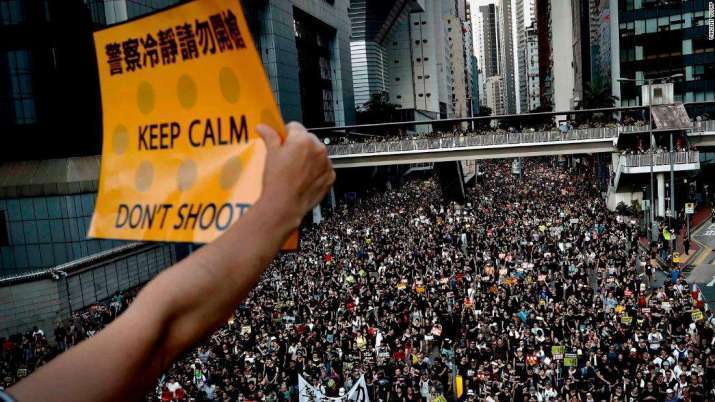FEATURES|THEMES|Social Engagement
From Hong Kong: How Mindfulness Practitioners Can Engage with Society in Difficult Times
 From cnn.com
From cnn.comThis article was originally published on Buddhistdoor Chinese. The following is an English-language translation of that article.
In the past, I have written about being a mindfulness practitioner. It is an important part of my practice to participate in social work with wholesome intentions. On one hand, during a contentious social movement I will be able to see my attachment to a position and the lack of wisdom. In these times, I can see the need for a pause and some mindfulness practice. If my involvement in social action is coming from the perspective of ego or self-interest, this moment of mindfulness is even more important. We know that there are always disputes, and that disputes do occur within social movements. The left wants to eliminate the right, and the right wants to eliminate the left. It is easy to become intoxicated by hatred, indignation, and fear. On the other hand, righteous thoughts can perceive the various emotional energies that are raised in our hearts, and at the same time create a space for friends and relatives around us to break away from the idea of binary opposition.
Ever since the massive public demonstration in Hong Kong on 9 June, I have felt a strong collective sentiment in mindfulness groups. The bodies and minds of fellow practitioners have become exhausted by the ongoing social upheaval. It has been said that every Hongkonger has taken up a second job and worked harder than usual to push themselves, which has supported the region. However, it is easy for people to lose themselves. Our daily habits have come to include obsessing over mobile phones, participating in demonstrations, discussing strategies, and so on.
Less and less time is being spent exploring the experience of this moment, and a lot of trauma has been experienced in the protest movement. Our emotions have been suppressed and held back under pressure, until they erupt.
I have wondered: can a mindfulness practitioner transcend political positions and walk side by side with all of the people of Hong Kong? I believe that the first step should be to create spiritual space for the people around you (including yourself). By simply establishing a dialogue in an oppressed society, we allow the most deeply buried emotions to flow in a safe environment, thus creating a safe space for those in need.
So I connected with friends with whom I have practiced meditation for 10 years. By starting social engagement in this way—going to different districts on different dates and times—we can establish a “Hongkonger” identity and temporarily put down the heavy burden we feel to let the people’s feelings flow.
In the past, as practitioners we did not know how to offer peace, stability, and wholesome thoughts in social movements. Perhaps we can bless society from our homes, but this is far from the real feeling of direct contact. In this practice, I believe that we have discovered roles and ways we can contribute, and we also have an opportunity to learn. It is a kind of practice to listen to the suffering of the world.
I would like to share a real experience here. I remember one listening session in which several youngsters bowed their heads and stayed very quiet for a while. The way they looked at the speakers struck me: their facial expressions revealing desperation, helplessness, and the sense of lost direction. Our senior practitioners sat with these young people, offering a space with wholesome and mindful thoughts, and giving the presence of their hearts. We didn’t expect that they would share anything as we also accepted their silence and everything else at that moment. Then, after we had stayed quiet for about five minutes, one of the young people finally sighed softly.
The youngster said: “My heart feels pressured; pressured by a huge stone.”
We replied: “Heart is being pressured; pressured by a big stone.”
Another five minutes passed.
The youngster said: “No hope.”
We replied: “You think there is no hope.”
Another five minutes passed.
The youngster said: “Even though there is no hope, we are worried.”
We replied: “No hope? Plus worries!”
These five-minute silences and one-line dialogues passed, one after another, and the youngsters began sharing more about what was burdening their hearts. The most memorable part was when one of them said: “Although I feel hopeless, I have no regrets because I have not hurt anyone. I am proud of myself. I appreciate myself.”
I do not know if you have witnessed the power of words. My fellow practitioners and I were moved to tears at this moment because we were seeing strength. We all remember that when the young man left the activity room, his face was smiling and his body was full of vitality. He had come in slouching under the weight of the world, and people were moved to tears.
This is a way in which mindfulness practitioners can engage with social movements. We may not be on the front lines in a suit of armor made from bravery, but we have even greater powers that others have not discovered. It is a part of participation to give peace, righteous thoughts, and presence to yourself, to others, and to society.
Related features from Buddhistdoor Global
Why Fold Paper Cranes? Japanese American Buddhists and Today’s Migrant Crisis
Buddhistdoor View: Seeing Our Common Dignity in the “Summer of Dissent”
The Trump Presidency and Lessons I Refuse to Learn
Buddhistdoor View—Learning From Race Issues in The United States
Buddhistdoor View: The Complexities of Buddhist Conversion and the Indian Dalit Movement
Buddhistdoor View: Honoring the Lessons of Martin Luther King Jr. for Today’s World














